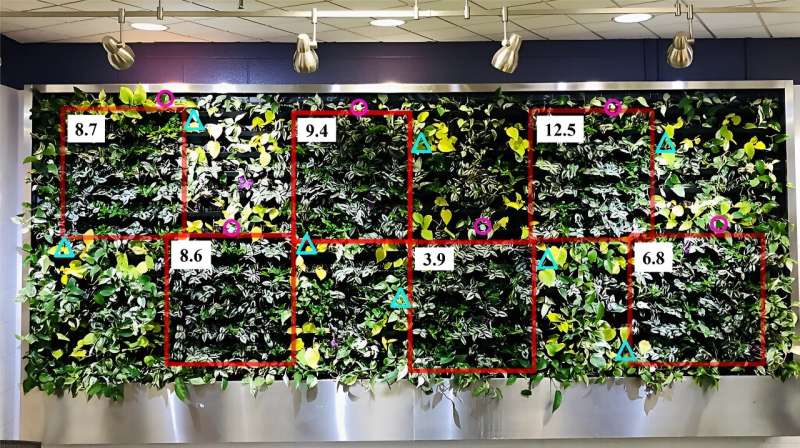This article has been reviewed according to Science X's editorial process and policies. Editors have highlighted the following attributes while ensuring the content's credibility:
fact-checked
peer-reviewed publication
trusted source
proofread
Interior green wall plants treated with antigibberellin plant growth regulators show controlled stem growth

As more businesses recognize the many benefits of having plants in the workplace, interior green walls, also known as living walls, have gained popularity in recent years for their aesthetic appeal and environmental benefits. However, managing plant growth within these structures presents unique challenges, particularly regarding stem elongation, which can impact the overall appearance and health of the green wall.
In most cases, professional interiorscaping firms are hired to maintain these systems. Most green walls cover a large area, making maintenance a significant expense. Plants in interior environments tend to develop unattractive growth with elongated internodes in response to low light levels, as well as low-quality light, leading to a less aesthetically pleasing plant display.
To maintain a green wall appearance, an interiorscaper must trim specific plants or replace them altogether. This frequent labor activity by the interiorscaping firm increases maintenance costs that must be passed on to clients.
A recent Kansas State University study has focused on the application of antigibberellin plant growth regulators (PGRs to) potted zebra plants and inch plants, two common household plants in the spiderwort genus, used in interior green walls. The results demonstrated that treatment with antigibberellin PGRs effectively slowed stem elongation in both species, leading to more compact and easier-to-maintain growth patterns.
Spiderwort (Tradescantia sp.) plants are commonly used in interior plantscaping, including zebra plant, purple heart (Tradescantia pallida "Purple Heart'), and oyster plant (Tradescantia spathacea). Spiderworts can tolerate light levels as low as 30 to 50 µmol·m−2·s−1, but more light is preferred. Plants need to be maintained at a temperature between 65 and 80 °F and be allowed to dry down between watering events. To maintain an attractive plant, vining species must be pinched regularly.
Antigibberellin application slowed growth in internode length of spiderwort selections during the first month after installation in a green wall. Antigibberellins were more effective in zebra plants at reducing overall stem growth rate and less so on inch plants. Paclobutrazol, applied both as a foliar spray and drench, resulted in similar reduction in stem elongation. The authors recommend a pre-installation foliar spray of 80 ppm or 4 ppm drench for controlling stem growth across spiderwort selections
The results of this research indicate that administering antigibberellin plant growth regulators (PGRs) to plants prior to their placement in green walls effectively retards stem elongation. This method aids in preserving the visual appeal of green walls, while simultaneously promoting the health and durability of the plants, potentially leading to decreased maintenance expenses.
More information: Lane W. Wiens et al, Treatment of Potted Zebra Plant and Inch Plant with Antigibberellin Plant Growth Regulators Slows Stem Elongation in an Interior Green Wall, HortTechnology (2023). DOI: 10.21273/HORTTECH05178-22
Journal information: HortTechnology
Provided by American Society for Horticultural Science




















